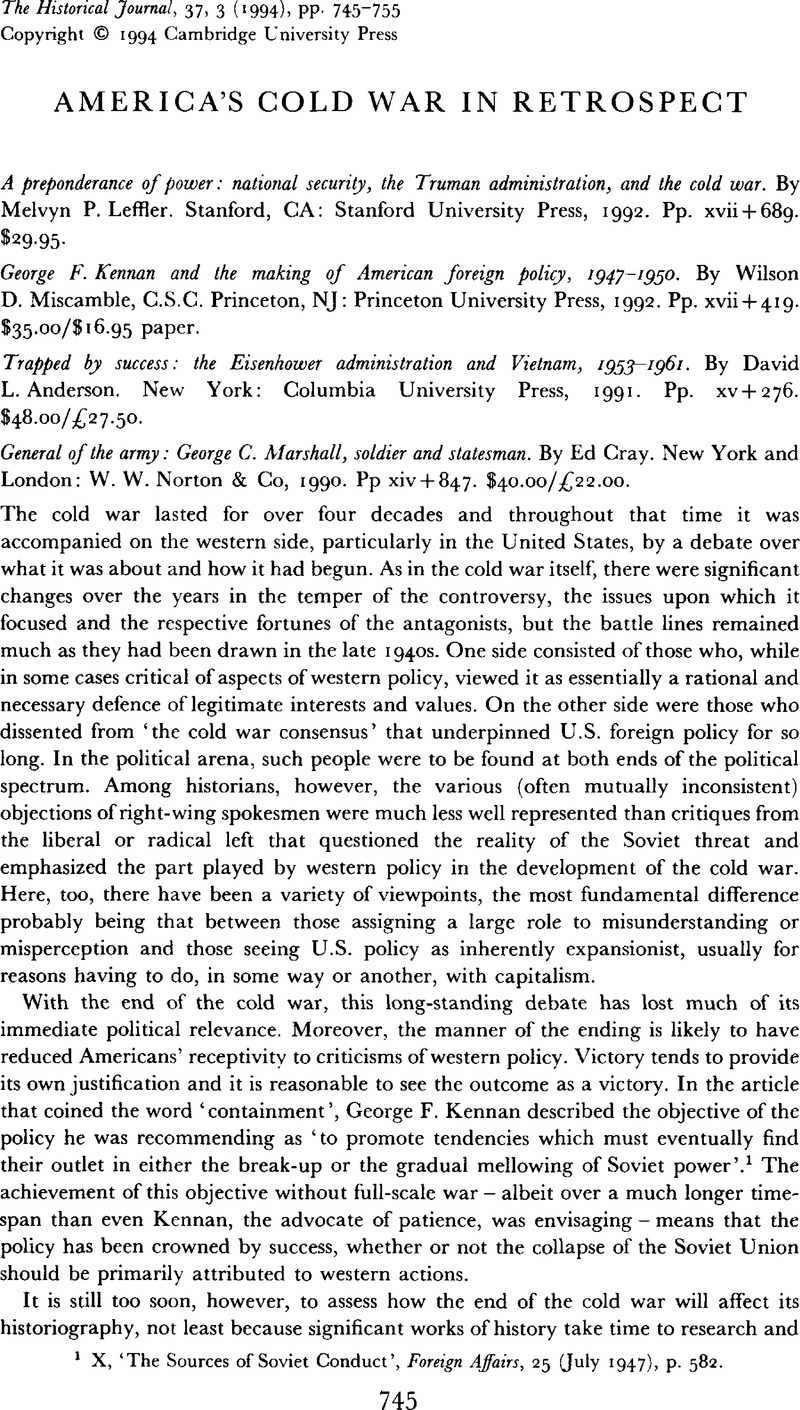No CrossRef data available.
Article contents
America's cold war in retrospect
Published online by Cambridge University Press: 11 February 2009
Abstract

- Type
- Review Articles
- Information
- Copyright
- Copyright © Cambridge University Press 1994
References
1 X, , ‘The Sources of Soviet Conduct’, Foreign Affairs, 25 (07 1947), p. 582.CrossRefGoogle Scholar
2 E.g. Hogan, Michael J., The Marshall Plan: America, Britain and the reconstruction of western Europe, 1947–1952 (Cambridge, 1987)CrossRefGoogle Scholar; Stueck, William W. Jr., The road to confrontation: American policy toward China and Korea, 1947–1950 (Chapel Hill, NC, 1981)Google Scholar; Blum, Robert M., Drawing the line: the origins of American containment policy in East Asia (New York, 1982)Google Scholar; Hess, Gary R., The United States' emergence as a southeast Asian power, 1945–1950 (New York, 1987).Google Scholar
3 Notably, , Gaddis, John Lewis in Strategies of containment: a critical appraisal of postwar American national security policy (New York: O.U.P., 1982).Google Scholar
4 Apart from Strategies of containment (note 3 above), Gaddis's major publications on the cold war are The United States and the origins of the cold war, 1941–1947 (New York, 1972)Google Scholar; The long peace: inquiries into the history of the cold war (New York, 1987)Google Scholar; and The United States and the end of the cold war: implications, reconsiderations, provocations (New York, 1992).Google Scholar
5 On these points, see Gaddis, , The long peace, pp. 20–43, 62.Google Scholar
6 Gaddis, John Lewis, ‘The emerging post-revisionist synthesis on the origins of the cold war’, Diplomatic History, VII (Summer 1983), 184Google Scholar; The long peace, pp. 104–46.Google Scholar
7 The long peace, pp. 56–71.Google Scholar
8 Among the other notable studies of Kennan published in recent years are Gellman, Barton, Contending with Kennan: toward a philosophy of American power (New York, 1985)Google Scholar; Hixson, Walter L., George F. Kennan: cold war iconoclast (New York, 1989)Google Scholar; Mayers, David Allan, George Kennan and the dilemmas of U.S. foreign policy (New York, 1989)Google Scholar; and Stephanson, Anders, Kennan and the art of foreign policy (Cambridge, Mass., 1989).Google Scholar
9 Pogue, Forrest C., George C. Marshall: education of a general, 1880–1939 (New York, 1963)Google Scholar; George C. Marshall: ordeal and hope, 1939–1942 (New York, 1966)Google Scholar; George C. Marshall: organizer of victory, 1943–1945 (New York, 1973)Google Scholar; George C. Marshall: statesman, 1945–1959 (New York, 1987)Google Scholar; Stoler, Mark A., George C. Marshall: soldier–statesman of the American century (Boston, 1989).Google Scholar
10 See Steele, Richard W., ‘American popular opinion and the war against Germany: the issue of negotiated peace, 1942’, Journal of American History, LXV (12 1978), 704–23.CrossRefGoogle Scholar
11 ‘Negotiating from strength: Acheson, the Russians and American power’, in Brinkley, Douglas (ed.), Dean Acheson and the making of U.S. foreign policy (New York, 1993), pp. 178–86.CrossRefGoogle Scholar
12 For a perceptive discussion of the motivation of a number of them, see Isaacson, Walter and Thomas, Evan, The wise men: six friends and the world they made (New York, 1986), pp. 406–8.Google Scholar


